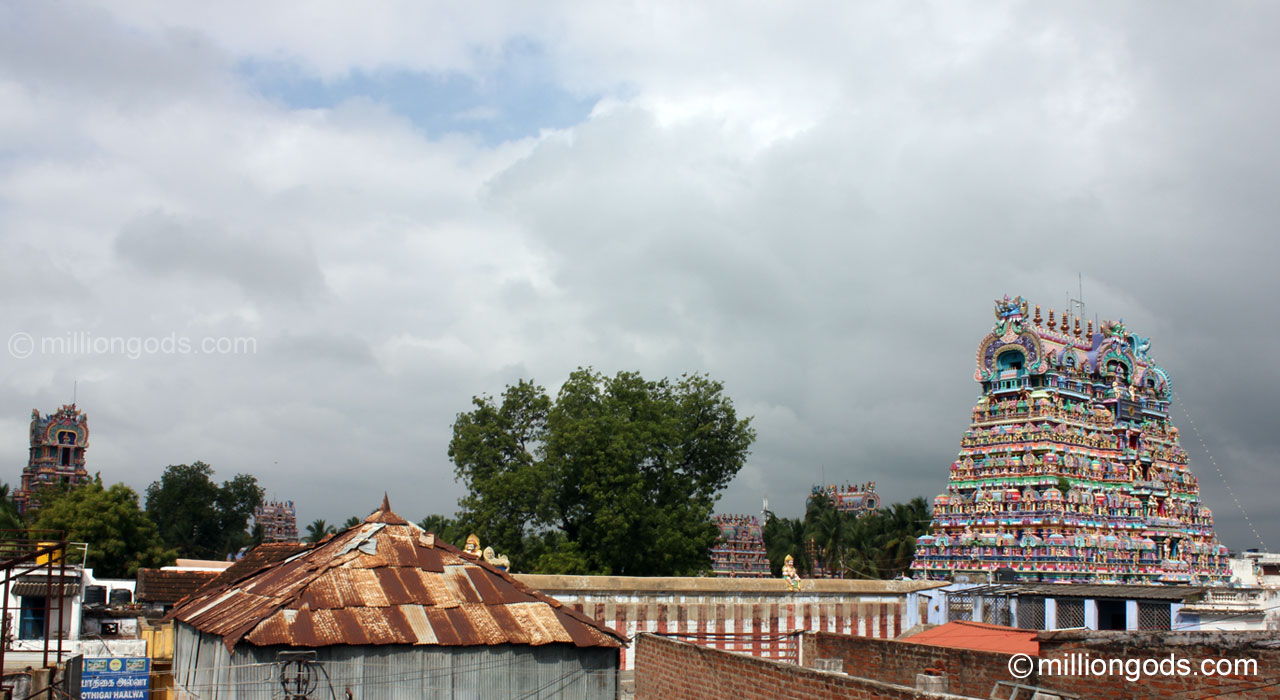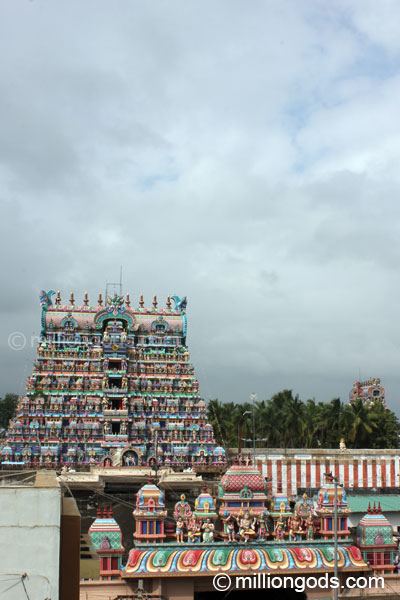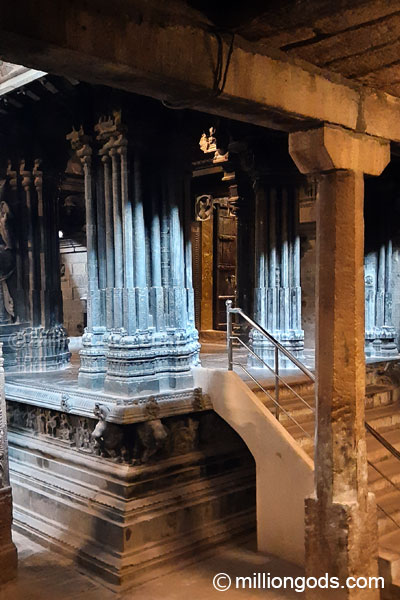Nellaiappar, facing east
Nellaiappar, Tirunelveli – Glorified

God
Goddess
Gandhimadhi Ammai (also called Vadivudaiammai), facing east
Other Deities
Being updated with temple layout
Nellaiappar Tirunelveli is a huge east-facing temple with two adjoining separate entrances and gopurams for both god and goddess who are east facing. The main deity is known by other names including Venuvana Naadhar, Vaei Mootha Naadhar, Nelveli Naadhar, Saalivadeesar, Venuvana Mahalingeswarar, and Venuvaneswarar. Next to the sanctum of the main deity is a sanctum of Lord Vishnu in a large reclining form with an image of Shiva Lingam carved on his chest. Some of the other names of the temple are Paer Andam, Pralayachittam, Thenkanchi, Sivapuram, Trimurthupuram, Ibapuri, Kachabalayam, Brahmapuram, Dharanicharam, Vinduthalam, Kamakottam, and Sakala Sidhdhi Sthalam. The Gopuram of the main deity is 5 tiered and that of the goddess is 7 tiered. Both are east facing and have long passages leading inside. There are 4 Prakarams around the main deity and 2 Prakarams around the goddess shrine. The outer Prakaram of both are connected through a covered Passageway called the Sangili (Chain) Mantapam with a Gopuram on top called the Sangili Gopuram. Totally there are 5 Gopurams here including the three already mentioned. The other two are in the north and west side of the temple. In front of the Goddess’ shrine is a beautiful temple tank called Porthamarai Kulam. Another larger temple tank is outside and east of the temple on the road leading down to the Rajagopuram of the main deity. The sculptural splendor of this temple is very great. The large sculptures of Arjuna, Veerabadhra, Pakadai Raja, and Karna before the sanctum of the main deity speak volumes of the craftsmanship during the Nayak Rule. There is a beautiful carving of the 12 Zodiac signs on the ceiling of the entrance to the sanctum. The wooden carvings of Devas congregated to watch the Lord’s cosmic dance in the Thamira Sabhai si another great aspect. West of the lord’s sanctum is the shrine of Lord Muruga as Arumuga. The six faces of the large Arumuga idol are visible from all sides as you circumambulate around him. Carvings of Ravana trying to lift Mount Kailsash, performing on the Yazh (a string musical instrument), and a depiction of the goddess embracing the lord in fear as he attempts to lift the Kailash mountain are worth spending time to observe the details. The Mandapams in Nellaiappar Tirunelveli are large and created very artistically and intricately. Some of them are 1000 Pillar Mandapam, Oonjal Mandapam, Somavara Mandapam, Sangili Mandapam, Mani Mandapam, Vasantha Mandapam. Another mandapam called the Sindupoonthurai Mandapam (Thaipoosa Mandapam) is seen on the banks of the Tamiraparani River flowing in the east. There are 5 temple cars for all the main deities. The one belonging to the main deity is among the largest ones in Tamilnadu and was created in the early 1500’s CE. The car streets were created by Ariyanatha Mudaliar, the famous minister and commander of the Nayak Kings. The Car of the goddess is considered exceptionally carved with more than a thousand wooden miniature idols.
Nellaiappar Tirunelveli is one of the 5 Sabha Temples in Tamilnadu where Lord Shiva is believed to have performed his cosmic dance.
The Five Sabhas are:
Rathina Sabhai at Vada Aaranyeswarar Temple in Thiruvalangadu (Dance – Oorthuva Thandavam)
Por Sabhai at Natarajar Temple in Chidambaram (Dance – Ananda Thandavam)
Velli Sabhai at Meenakshi Amman Temple in Madurai (Dance – Sundhiya Thandavam)
Thamira Sabhai at Nellaiappar Temple in Tirunelveli (Dance – Muni Thandavam)
Chithira Sabhai at Kutralanathar Temple in Kutralam (Dance – Thripura Thandavam)
Holy Water (Theertham) – 32 Theerthams including Porthamarai Kulam, Sorna Pushkarini, Karumari theertham, Sindhu Poonthurai
Sacred Tree (Sthala Vriksham) – Moongil (Bamboo – Bambusa sps)



History
Thirugnanasambandar (7-9th Century CE) has visited and rendered Hymns for the lord here at Nellaiappar Tirunelveli. Thirunavukkarasar and Sundarar are also said to have visited and sung here, but the hymns have not been discovered yet. There are over 50 inscriptions here and the earliest one is dated between 945-966 CE during the rule of Chozhan Thalaikinda Veerapandyan in Vattezhuthu script. The inscription mentions the contribution of a Daasi for the burning of lamps every day. The lord is mentioned as ‘Thirunelveli Brahmapuri Devar’. Inscriptions belonging to Chola Kings Rajendra I (1012-1044 CE) and Kulothunga I (1070 – 1120 CE) are seen in the first Prakaram Pillars. Inscription of Jadavarman Kulasekaran (Pandya King, 1190 – 1216 CE) pertaining to land donation mentions the lord’s name as ‘Thirunelveli Udaya Nayanar’. Other inscriptions include Sundara Padyan (1216–1238 CE), Vikrama Pandyan ( 1250 – 1276 CE), Veera Someswaran (1238-1258 CE), Maravarman Sundarapandyan II (1251 CE relating to the dance festival of Thiruvadirai), Jadavarman Veerapandyan II (1258-1265 CE), Maravarman Kulasekaran I (1268–1310 CE pertaining to the building of the compound wall), Sundara Pandya IV (1309–1327 CE, creation of the shrine of Polla Pillayar), Parakrama Pandya (1422–1463 CE?, Lord mentioned as Venu Vana Naadhar) and Veerasangili Marthandavarman (1546 CE, creation of the musical pillars).
Legend
The legend behind the name of Nellaiappar Tirunelveli came about when the Lord stood as a protective fence to safeguard the rice grains of a devotee from the downpour. He had begged and collected it to offer to the Lord. Thus came about the name Thiru Nel(Paddy-Rice) Veli(Fence). Goddess Parvati is believed to have performed penance and worshiped the Lord here to protect the world and to marry him. Sage Agastya worshiped the Lord here and was blessed with the vision of the marriage of Shiva and Parvati in Mount Kailash. The four Vedas are present here as four trees, considered merged into the Sthala Vriksham – Bamboo. A king called Indradyuman was relieved from the curse of Sage Durvasa after having a dip in the holy tank called Kari Urumari Theertham here at Nellaiappar Tirunelveli. It is believed that the lord is the water and the Brahma bloomed as a golden flower in the Porthamarai Kulam in front of the Goddess Sanctum.
A king called Swetha Kethu who had no progeny was praying to the lord here at Nellaiappar Tirunelveli during his old age. The noose of Kaala that was to take the life of the king accidentally touched Lord Shiva also. Enraged he kicked Kaala with his feet and blessed the king that he could attain the end only when he wished to. This event is depicted as a carving in the Murugan shrine area and also celebrated every year thrice during the Tamil month of Vaikasi (May-June).
Directions
Nellaiappar Tirunelveli is in the center of Tirunelveli Town and can be reached easily from all around.
Stay and Food
Tirunelveli has some good restaurants and hotels and can be your base for traveling around. Just outside the main gopuram is the famous Iruttu Kadai selling the best Halwa in town. It is open only from 5 pm in the evening and closes early. There would be a queue from 4 pm itself. Also famous is the original Santhi Sweets on the main road outside the Railway Station. There will be a crowd in front always and you can easily find out the original shop from the scores of shops with the same name.

